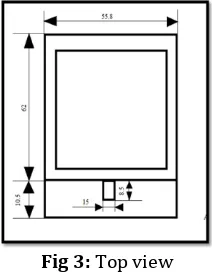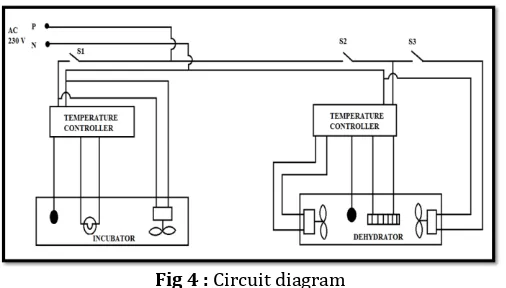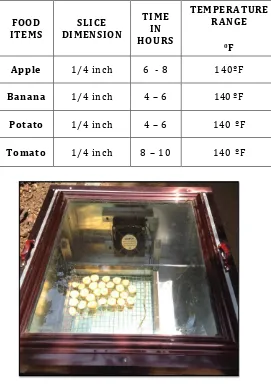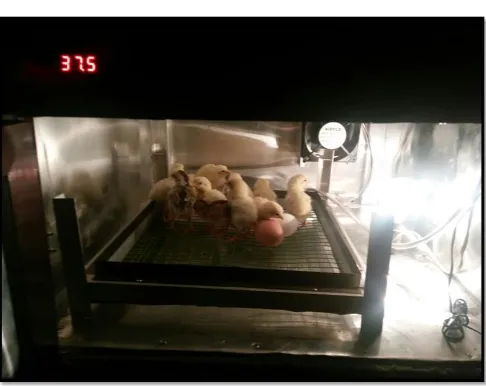© 2016, IRJET | Impact Factor value: 4.45 | ISO 9001:2008 Certified Journal | Page 2513
Design and Fabrication of Hybrid Dehydrator with Incubator
P Navaneethakrishnan
1, Belvin Benny
2, Deepak P M
2, Gopu N Kmar
2, Rishad A R
2, Sahanas S
21
Asst.Professor, Dept. of Mechanical Engineering, Ammini college of Engineering, Kerala, India
2Student, Dept. of Mechanical Engineering, Ammini college of Engineering, Kerala, India
---***---Abstract –
The paper is a novel design of coupling a dehydrator and an incubator as a single unit. The dehydrator is hybrid as it uses both solar as well as an electric heater to get the required temperature. The dehydrator and incubator are designed at the top and bottom of a box. Temperature controllers are used to maintain the desired temperature and fans are used to distribute the heat uniformly. The unit is designed, fabricated and tested for its efficiency.Key Words: Hybrid Dehydrator, Incubator, Hatching
efficiency, solar collector efficiency.
1. INTRODUCTION
Food drying is way to preserve food and vegetables and a dehydrator is a device that removes moisture from food to aid its preservation. Removal of moisture from food items prevents bacteria from growing and spoiling food which requires heat. The heat source may be using solar or electric power. The novel design of hybrid dehydrator enables simultaneous use of both solar and electric heat source [1]. The solar energy itself is used in two ways, by direct irradiation as well as by heating air in a solar collector. This hybrid dehydrator is coupled to an incubator in a box to form a single unit. The incubator is used for hatching eggs [2]. It consists of two removable trays designed for a capacity of 70 eggs.
The required temperature in the drier and incubator is maintained by separate temperature controllers and distributed by fans. The incubator is designed to maintain a constant dry bulb temperature of 37.5oC and the
temperature in the dehydrator is set according to the food item to be dried.
2. DESIGN
The designing of hybrid dehydrator with incubator is divided into two sections.
a. Box design b. Circuit design
2.1 Box Design
The upper part of the box is designed for the dehydrator and the lower part for the incubator. The views along with the dimensions (in cm) are shown in fig 1 and fig 2. The space for exhaust vent and the solar collector are shown in the left and right side views.
Fig1: Front and back view
Fig 2: Left and right side views
The ventilation is just a movable door with rectangular section. Small handle is installed to the ventilation door for easy opening and closing. The ventilation is sandwiched between the outer and inner layer of the box.
Fig 3: Top view
[image:1.595.326.556.198.467.2] [image:1.595.380.486.563.700.2]© 2016, IRJET | Impact Factor value: 4.45 | ISO 9001:2008 Certified Journal | Page 2514
[image:2.595.36.289.125.269.2]2.2 Circuit design
Fig 4 : Circuit diagram
A 230 V AC supply is given to the circuit. The supply to the incubator and dehydrator units is controlled by the switches S1, S2 and S3. There are mainly 12 ports available in the temperature controller. The supply from the switch is connected to the 12th port and neutral is connected directly
to the 10th port. The sensor is connected to the 7th and 8th
port of the temperature controller. In the incubator the bulb and the fan is connected to the closed port of the temperature controller relay. In the dehydrator the heating coil and the fan is also connected to the closed port but the second fan is connected to the supply directly.
2.3 Design Methodology
Dehydrator:
The drying process is done with the help of sunlight and electric heater .The device is capable of drying even with one source of energy.
Assumption:
1) The heat obtained is calculated on the basis of steady condition.
2) The values are taken after conducting
experiments on the device in a clear sunny day.
The materials behave as per their design specification almost at 90% efficiency.
The amount of heat required for drying
material:
We know
Q = mCp∆T
Mass of drying item, m = 1 kg
Specific heat (maximum), Cp = 3.3 kj/kgK
Temperature change from 38oc atmospheric to 600c
drying temperature, ∆T = 220C
Heat required for drying, Q = 1*3.35*22*103
= 73700J.
Drying by solar collector
Considering that the direct sunlight falling on the material through the glass plate is negligible (In direct method). For collector we have
Length, l = .460m Breadth, b = .554m Thickness, t = .104m
Volume of solar collector
V = l*b*t
=.460*0554*.104
= 0.02650m3
Solar collecting area
Total surface area, As= 2(l*t) +2(b*t) +l*b
= .465752m2
Energy falling from sun to collector
Incident energy = E*A
Where sun input, E = 900w/m2 (pyranometer)
Considering losses in components the input may reduce as follows:
E =900*ᶯreflector*ᶯblack body*ᶯconstruction
E = 900*0.90*0.9*0.90 Solar radiation = 656.1w/m2
Incident solar heat energy = E*A = 656.1*(b*l)
= 656.1*(0.554*0.460) =167.200W.
Assuming only the average value of solar energy due variation in intensity we get,
Incident energy = 167.200*0.40 Incident energy = 66.88W
Heat produced in solar collector for about 15 minute
Q = m*Cp*∆T
Initial temperature; T1 = 380C
Final temperature; T2 = 660C
Change in temperature, ∆T = 280C.
Since the air is flowing at a velocity of 0.02m/s with density 1.225kg/m3 and area we get mass flow rate.
m∙ = ρ*A*c
= 1.225*(l*b)*0.02
© 2016, IRJET | Impact Factor value: 4.45 | ISO 9001:2008 Certified Journal | Page 2515 Available heat produced in collector
Q = m∙*Cp*∆T
= 1.173*10-3*1.005*103*28 = 32.980W.
We know
Efficiency = output/input
= 32.980/66.80 = 49.380%.
Drying by direct sunlight (Direct sunlight drying by top glass)
Incident energy = 656.1w/m2
Area of top chamber = 0.620*0.554
= 0.34348m2
Taking the sunlight variation 40% we get
Incident energy = 656.1*.40*0.34348 = 90.14W.
Heating by space heater:
The space heater is selected according to the amount of heat required and time. For drying completely in 1 hour a heater capable of producing 73700J is selected.
250Whr= 900kJ. Calculating the effect of heat on material:
The total volume of chamber = l1*b1*t1
Where , b1=0.360m
l1= 0.558m
t1= 0.620m
Volume of triangular section, V1 = 0.1236m3
Volume of square section, V2 = 0.5*b2*l2*t2
= 0.5*0.620*0.049*0.554
= 0.00841m3
Total volume V = V2 + V1
= 0.00841+0.1236
= 0.13201m3
Volume of food material:
The volume occupied by the food material is also the volume occupied with the tray.
i.e., volume of food material + tray
Assuming a 30 slices of food material with 1.5 cm thickness, radius of 2cm is placed on the tray the volume will be
η
V =π/4*(4*10-2)2*(1.5*10-2)*30
=5.6548*10-3m3
Volume of tray taking
Length, l = 35cm
Breadth, b =50cm
Height, h = 3.6cm
V = 0.350*0.50*3.6*(10-3)
= 6.3*10-4m3
Total volume of food material = (5.645+6.3)*10-4
= 1.1954*10-3 m3
So we know that
Volume of air = 0.13081m3
Volume of food = 0.001195m3
The heat produced by heater is divided into food in lesser quantity than to the air .So by accounting some factor of safety 1.8 the heater is chosen as
250*1.8 = 450W.
Incubator:
Dry bulb temperature, Td = 37.50C (constant for incubator)
Wet bulb temperature, Tw = 340C (from
thermometer)
Partial pressure of water vapour,
Pv= Psw–[(Pa–PSW)(Td-Tw / 1547-1.44Tw]
= 0.05318 – [(1.01325– 0.05318) (37.5 – 34) / 1547– 1.44*34]
= 0.05138 – (3.360/1498.04)
© 2016, IRJET | Impact Factor value: 4.45 | ISO 9001:2008 Certified Journal | Page 2516
Relative humidity, Ф = Pv
/
P
sd= 0.0509/0.0644
(Psd; pressure corresponding to Td, from steam
table)
= 0.7892
=
78.92%.
From psychometric chart relative humidity = 80%.
3. FABRICATION
The basic components involved in the fabrication of hybrid dehydrator with incubator are:
Temperature controller (SELEC – CH – 403) Temperature sensor ( NTC type Thermistor) Heating coil (430W – 230V space heater)
Fan (AIRFLO- 230V – 120mm x 120mm x 130mm) Bulb(60W – 230V)
Switches and wires (toggle type)
The fabrication is done such that the dehydrator is at the top and the incubator is at its bottom. It is to enable direct sunlight drying in the drier. Aluminium channels are used to create the structure and covered with sheet metals. To prevent heat loss they are covered with double walled PVC sheets with insulating foam in between. The top of the drier is covered with glass at an angle of 90. The control panel is
[image:4.595.304.575.358.745.2]placed in between the dehydrator and the incubator in a separate insulated chamber. The heating coil is fixed on to the wall of the dehydrator and the fans are attached to the vent. The wires are covered with plastic sleeves to prevent heat loss and are insulated from the main body. Air vents are proved for ventilation and to maintain the required humidity. The dehydrator has only one opening whereas the incubator has two.
Fig 5: Fabricated unit
A movable solar collector is connected to the incubator through a flexible vent (rubber hose). It enables it to be kept at any orientation. The collector is completely coated black with a transparent cover at its top. Wheels are attached to the bottom of the hybrid box to facilitate easy movement. Handles are provided at top for easy lifting. The details are tabulated below:
4. TESTING
The testing of hybrid dehydrator with incubator gives the following result:
DEHYDRATOR
The sample from the table is selected and the results [3] are tabulated as follows.
Table - 1: Dehydrator test results
FOOD
ITEMS DIMENSION SLICE
TIME IN HOURS
TEMPERATURE RANGE
0F
Apple 1/4 inch 6 - 8 140ºF
Banana 1/4 inch 4 – 6 140 ºF
Potato 1/4 inch 4 – 6 140 ºF
Tomato 1/4 inch 8 – 10 140 ºF
[image:4.595.102.222.578.746.2]© 2016, IRJET | Impact Factor value: 4.45 | ISO 9001:2008 Certified Journal | Page 2517
INCUBATOR
A sample of 15 chicken eggs is selected for testing and the procedures for incubation are done according to the incubation chart[4]:
Total eggs place = 15
Total eggs hatched = 13
Efficiency of incubator = (13/15)*100 %
= 86.66 %
Fig 7: Incubator test results
5. CONCLUSIONS
The hybrid drier and incubator is designed, fabricated and tested. The drier capacity is designed for a capacity of 1kg and the incubator capacity is for 70 eggs. The system is semi automatic as the temperature is automatically controlled. The drying time of the test specimens is comparable with the standard drying times obtained from the dehydrator chart. The incubator efficiency is obtained as 86.6%. This unit can be used for domestic purposes under all weather conditions. The unit costs about 7500 Indian rupees which is affordable when compared with the separate costs of dehydrator and Incubators in the market.
REFERENCES
[1] Guofeng Yuan, Liang Hong, Xing Li, Li Xu, Wenxue Tang,
Zhifeng Wang “Experimental investigation of a solar dryer system for drying carpet”, International Conference on Solar Heating and Cooling for Buildings and Industry, vol.70, pp. 626 – 633, 2015.
[2] Gbabo Agidi, J.T Liberty, O.N Gunre, G.J Owa “ Design
construction and performance evaluation of an electric powered egg incubator”, IJRET, vol. 03, issue 03, pp. 521 – 526, March 2014.
[3] Conditions for drying different types of food, Available
at: https://www.excaliburdehydrator.com/intro-to-dehydrating/.
[4] Conditions for hatching diifferent eggs, Available at:
[image:5.595.30.273.261.454.2]


